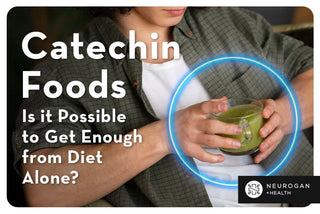Catechins are natural polyphenolic compounds most commonly associated with green tea or cacao. When you hear that these foods are good for you, it's often because catechins help support heart health, muscle function, and overall antioxidant effects [1].
Catechins (C) can be divided into different types, such as epicatechin (EC), gallocatechin (GC), epigallocatechin (EGC), epicatechin gallate (ECg), and epigallocatechin gallate (EGCg).
You might notice epicatechin supplements are used frequently for muscle health.
Epicatechin is just one of the types of catechins, with a lot of research surrounding its potential to boost muscle growth by increasing nitric oxide and inhibiting myostatin — a protein that limits muscle mass growth [2].
The tricky thing is that we don't often get enough of catechin or epicatechin in our diet alone to see these beneficial effects, which is where supplements can be a great way to get consistent high doses of catechins.
Catechin Food Sources
Catechin is found in foods like green tea extract, cacao, and certain fruits — but can you get enough catechins from diet alone to make the most of its health benefits?
Unfortunately, the amounts found in these foods aren’t always significant or consistent enough for daily needs, especially if you’re to fulfill certain wellness goals like building stronger muscles or supporting cardiovascular health.
Green tea is one of the richest sources of catechins. It generally contains 80-90% catechins of the total flavonoid content. The most abundant catechin is EGCG (about 60%), followed by EGC (20%), ECG (14%), and EC (6%) [3].
You also have to consider other variables, such as the quality of green tea and how you're preparing it.
Red wine also contains catechins, though in lower amounts (27 to 96 mg per liter) [4]. At this point, drinking a liter of red wine daily isn't exactly healthy.
Other food sources like apples, berries, and dark chocolate also contain catechins, but the quantities vary, and it would require quite a bit of these foods to reach meaningful levels.
|
Food Source |
Catechin Content (mg per serving) |
|
Green Tea (1 glass) |
50-100 mg |
|
Red Wine (1 glass) |
15-30 mg |
|
Dark Chocolate (50g) |
10-20 mg |
|
Strawberries (1 cup) |
5-10 mg |
Let’s take a closer look at some foods containing catechins and how practical they are as sources.
Green Tea
Green tea is by far one of the most potent sources of catechins.
High-grade green tea, such as Japanese sencha or matcha, has higher levels of catechins. And to preserve the catechins, you want to ensure you’re not overbrewing it.
Green tea is brewed at lower temperatures (around 160°F to 170°F) and for a shorter time (1-2 minutes) to minimize catechin degradation. Over-brewing can lead to a loss of catechins and a bitter taste.
A cup of green tea (about 240 mL) can have up to 100 mg of catechins, depending on how it’s brewed. You’d need multiple cups per day for optimal health effects.
Dark Chocolate & Cacao
Dark chocolate and cacao are also good sources of catechins, with 50 g of dark chocolate containing around 10 to 20 mg of catechins. Again, you’d need to consume a large portion, and dark chocolate's added sugar and calories can make it less ideal if consumed in high quantities.
Berries
Berries like strawberries and blackberries contain catechins, but the amounts aren't very high. For instance, a cup of strawberries contains about 5 to 10 mg of catechins. They make an excellent addition to your diet but aren’t a reliable primary source.
Red Wine
Red wine has some catechins, with one glass (about 150 mL) containing roughly 15 to 30 mg. However, the amounts are not enough for consistent health benefits, and alcohol consumption comes with its own set of considerations.
Why Supplements Might Be Necessary
Relying entirely on food for catechin intake might not be the most efficient way to ensure you’re getting enough of these beneficial compounds. While adding foods like green tea, dark chocolate, and berries to your diet is undoubtedly helpful, it isn’t easy to consistently reach the optimal levels needed to really reap the health benefits.

For instance, our Epicatechin capsules contain 500 mg of pure epicatechin — and you can take up to 2 capsules daily for a 1000 mg dose, equivalent to roughly 5000 g (5 kg) of dark chocolate — not exactly a balanced diet.
This is why supplements provide a reliable, concentrated source of catechins, ensuring you’re getting the right dose every day without having to change your diet dramatically.
Resources:
- Sutherland, B. A., Rahman, R. M., & Appleton, I. (2006). Mechanisms of action of green tea catechins, with a focus on ischemia-induced neurodegeneration. The Journal of nutritional biochemistry, 17(5), 291-306.
- Gutierrez-Salmean, G., Ciaraldi, T. P., Nogueira, L., Barboza, J., Taub, P. R., Hogan, M. C., ... & Ramirez-Sanchez, I. (2014). Effects of (−)-epicatechin on molecular modulators of skeletal muscle growth and differentiation. The Journal of nutritional biochemistry, 25(1), 91-94.
- Reygaert, W. C. (2018). Green tea catechins: Their use in treating and preventing infectious diseases. BioMed research international, 2018(1), 9105261.
- Arts, I. C., Van De Putte, B., & Hollman, P. C. (2000). Catechin contents of foods commonly consumed in The Netherlands. 2. Tea, wine, fruit juices, and chocolate milk. Journal of Agricultural and Food Chemistry, 48(5), 1752-1757.




